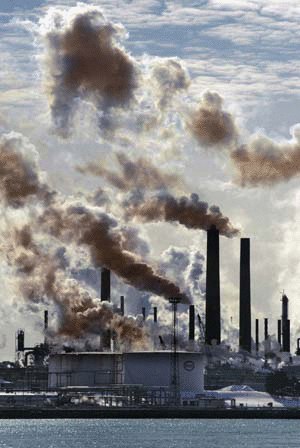UN Warns of Rise in Greenhouse Gases
November 20, 2012
Greenhouse gases have reached unprecedented levels, according to a report by the United Nations (UN) World Meteorological Organization. The report found that the global average of carbon dioxide (CO2) in the atmosphere reached 390.9 parts per million (ppm) in 2011. The concentration of CO2 in the atmosphere has grown by about 40 percent since the year 1750, at the beginning of the Industrial Revolution.
CO2 is released chiefly by burning such fossil fuels as coal and oil. China now produces more CO2 pollution than any other country, followed closely by the United States.
Climate scientists have found that increasing concentrations of CO2 and other greenhouse gases are the chief cause of global warming. Rising concentrations of these gases trap more of the energy in sunlight at Earth’s surface. Thus, the gases act somewhat like the walls of a greenhouse, which allow in light but prevent heat from escaping. As levels of greenhouse gases rise, they cause a gradual increase in Earth’s average surface temperatures known as global warming.

High levels of heat-trapping greenhouse gases are being released into the atmosphere by manufacturing and other human activities. (© age fotostock/SuperStock)
Global warming has already increased Earth’s average surface temperature by about 1.4 Fahrenheit degrees (0.76 Celsius degrees) since the mid-1800′s. Scientists predict that the average surface temperature will rise an additional 2.0 to 11.5 Fahrenheit degrees (1.1 to 6.4 Celsius degrees) by 2100. Climate scientists warn that severe global warming will do great damage to the natural environment and human society.
The UN report also found increases in greenhouse gases apart from CO2. The second most important greenhouse gas is methane, which is produced by natural gas extraction, agriculture, and landfills, among other human-made sources. Methane reached 1,813 parts per billion in 2011, an increase of about 259 percent above its level in 1750. Although the concentration of methane is much lower than that of CO2, methane is a more powerful greenhouse gas.
In May 2012, atmospheric concentrations of CO2 briefly surpassed 400 ppm in the Arctic, according to the National Oceanic and Atmospheric Administration. CO2 concentrations vary by latitude and season, mostly because growing plants take up significant amounts of CO2 through photosynthesis. Scientists expect average global CO2 concentrations to reach 400 ppm no later than 2016. The 400 ppm threshold has mostly symbolic significance, but many climate scientists warn that CO2 concentrations over 400 ppm will cause damaging levels of global warming.
Addtional World Book articles:
- Carbon footprint
- Intergovernmental Panel on Climate Change
- Kyoto Protocol
- Methane: Another Greenhouse Troublemaker (a Special Report)
- The Great Meltdown (a Special Report)


